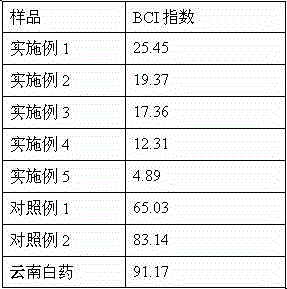Fibrous protein compound hemostatic material and preparation method thereof
A technology of hemostatic material and fibrin, which is applied in the field of medical materials, can solve problems such as easy detachment of the tourniquet, reduced hemostatic effect, and decreased oxygen content, achieving rapid and effective hemostasis, simple preparation method, and reduced bleeding volume
- Summary
- Abstract
- Description
- Claims
- Application Information
AI Technical Summary
Problems solved by technology
Method used
Image
Examples
Embodiment 1
[0020] A fibrin composite hemostatic material prepared from the following raw materials in parts by mass: 5 parts of carboxymethyl cellulose, 2 parts of carboxyethyl cellulose, 1 part of chitosan, 3 parts of starch, and 1 part of sodium trimetaphosphate , 1 part of sodium alginate, 3 parts of gelatin, 8 parts of soy protein isolate, 2 parts of lysine, and 20 parts of water.
[0021] The preparation method comprises the steps of:
[0022] 1) Add starch and chitosan to water, put in a constant temperature water bath, add sodium trimetaphosphate and stir, the temperature of the constant temperature water bath is 65°C, and the water bath is 40min;
[0023] 2) Add sodium alginate, gelatin, soybean protein isolate and amino acid to the solution in step 1), stir at 35°C for cross-linking reaction, and react for 12 hours;
[0024] 3) Add carboxymethyl cellulose and carboxyethyl cellulose to the solution in step 2), pour the film on a glass plate, freeze-dry, and peel off the film to ...
Embodiment 2
[0026] A fibrin composite hemostatic material, prepared from the following raw materials in parts by mass: 10 parts of carboxymethyl cellulose, 4 parts of carboxyethyl cellulose, 5 parts of chitosan, 8 parts of starch, and 3 parts of sodium trimetaphosphate , 4 parts of sodium alginate, 8 parts of gelatin, 12 parts of soy protein isolate, 5 parts of lysine, and 40 parts of water.
[0027] The preparation method comprises the steps of:
[0028] 1) Add starch and chitosan to water, add sodium trimetaphosphate and stir in a constant temperature water bath; the temperature of the constant temperature water bath is 65°C, and the water bath is 40 minutes;
[0029] 2) Add sodium alginate, gelatin, soybean protein isolate and amino acid to the solution in step 1), stir at 35°C for cross-linking reaction, and react for 12 hours;
[0030] 3) Add carboxymethyl cellulose and carboxyethyl cellulose to the solution in step 2), pour the film on a glass plate, freeze-dry, and peel off the fi...
Embodiment 3
[0032] A fibrin composite hemostatic material, prepared from the following raw materials in parts by mass: 6 parts of carboxymethyl cellulose, 3.2 parts of carboxyethyl cellulose, 2 parts of chitosan, 5 parts of starch, and 1.8 parts of sodium trimetaphosphate , 2 parts of sodium alginate, 5 parts of gelatin, 10 parts of soy protein isolate, 3 parts of arginine, and 25 parts of water.
[0033] The preparation method comprises the steps of:
[0034] 1) Add starch and chitosan to water, put in a constant temperature water bath, add sodium trimetaphosphate and stir, the temperature of the constant temperature water bath is 65°C, and the water bath is 40min;
[0035] 2) Add sodium alginate, gelatin, soybean protein isolate and amino acid to the solution in step 1), stir at 35°C for cross-linking reaction, and react for 12 hours;
[0036] 3) Add carboxymethyl cellulose and carboxyethyl cellulose to the solution in step 2), pour the film on a glass plate, freeze-dry, and peel off t...
PUM
 Login to View More
Login to View More Abstract
Description
Claims
Application Information
 Login to View More
Login to View More - R&D
- Intellectual Property
- Life Sciences
- Materials
- Tech Scout
- Unparalleled Data Quality
- Higher Quality Content
- 60% Fewer Hallucinations
Browse by: Latest US Patents, China's latest patents, Technical Efficacy Thesaurus, Application Domain, Technology Topic, Popular Technical Reports.
© 2025 PatSnap. All rights reserved.Legal|Privacy policy|Modern Slavery Act Transparency Statement|Sitemap|About US| Contact US: help@patsnap.com

